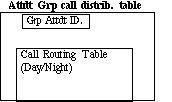ATTENDANT GROUP CALL DISTRIB.
The distribution of attendant group calls is made up of tables containing, in principle, attendant group numbers.

Calls destined for an attendant group are actually positioned on the 1st routing number of its table (see attribute Routing Numbers).
The origin of the calls directed onto the group attendant routing table is:
- attendant group call prefixes (internal or external)
- general attendant call prefixes
- calls coming from a NDID trunk line whose routing number calls this attendant group
- calls back on attendant following a set on enquiry call on the trunk line and hook-on
- attendant transfer
Attendant Group Id
This number identifies the attendant group call distribution table.
It is also used : by the attendant group call prefixes (see PREFIXES). While dialling this prefix the subscriber will have his/her call directed towards the numbers contained in this table.
Overflow Routing No.
The routing overflow number corresponds to the call number of a subscriber set ; this number is used in reduced service, as well as in routing overflow (see attribute Routing Numbers).
The directory numbers can not be forwarded in the following cases:
- multi-line number
- hunting group numbers (as well as the directory numbers integrated in the hunting groups)
- number of S0 sets
This number is managed by the "owner" attendant group (of the same attendant set ID).
Forwarding on routing
NO: If the routing overflow number (see this attribute) of any trunk is also introduced into one of the routing numbers (night, day, forwarding 1, forwarding 2), the forwarding on this overflow number will be direct regardless of other routing or overflow numbers.
YES: normal functionning: forwarding on routing numbers (see Routing Numbers).
NOTE :
This attribute is reserved for specific cases.
ATTENTION:
- DAY / ROUTING N°1 must be the directory number of the "owner" attendant group (of the same ID).
- NIGHT/ ROUTING N°1, must be the directory number of the "owner" attendant group (of the same ID) if it is not in the same node.
- you can enter the other numbers as you wish to do so, it is possible to put the directory numbers of the attendant groups, of the attendants, but also of the sets, hunting groups, automated attendant...).
There are 4 incoming routing types: NIGHT, DAY, MODE 1, MODE 2. The passage of one routing type to an other is controlled by certain attendant group sets (see ATTENDANT: Service Access Rights) or by unplugging the last attendant in the group (NIGHT).
----------------------------------------------------------------------
|ROUTING | |
|ACTIVATED | REROUTING IN CASE OF NO ANSWER |
|---------------------------------------------------------------------|
|NIGHT |1st No -->2nd No-->3rd No | overflow |
| | | routing |
|DAY |1st No -->2nd No-->3rd No | Number (see |
| | |-------> attribute |
|FORWARD 1 |1st No -->2nd No-->3rd No | overflow |
| | | routing |
|FORWARD 2 |1st No -->2nd No-->3rd No | number) |
----------------------------------------------------------------------
In each of the 4 routing types you can introduce 3 DIRECTORY NUMBERS, each of 1 to 8 digits:
- an incoming call is thus directed onto the 1st number, then after no answer (3 attempts), onto the second, then onto the third.
- if the third number does not answer the call is directed onto the routing overflow number table.
- if the third number does not answer and one of the numbers is an attendant's number, it is the time-out "attendant absent" which is taken into account: the call is directed onto the routing overflow number table after this time-out.
- if the routing type which is activated does not have a number, the call is directed directly onto the routing overflow number table.
The numbers must be introduced consecutively (For example: in night routing if only 2 numbers are used, they must be filled in in the 1st and 2nd fields and not, for example, in the 1st and 3rd fields).
According to the operation desired, each routing type can have 0, 1, 2 or 3 numbers, the same number can be introduced several times in the same routing type or in different routing types.
The 1st number of each mode NIGHT, DAY, MODE 1, MODE 2 (Main Routing Number) is man aged by the "owner" attendant group (of the same attendant set ID).
During the passage from one mode to another, the destination of the calls changes over from one routing N° 1 to another routing N°1
- if the "Routing N°1" of the 2 modes (Ex.: DAY and NIGHT) are identical, the calls stay destined for the same attendant group; the attendants see their new mode displayed (Ex.: NIGHT) but continue to operate, only unplugging will put them "out-of-service" (overflow onto N°2 of NIGHT),
- if the "Routing N°1" of the 2 modes (Ex.: DAY and NIGHT) are different, the new mode is displayed to the attendant (Ex.NIGHT) and changes to "out-of-service" (overflow onto N°2 of NIGHT).
Att.Group Status: NIGHT
Att.Group Status: DAY
Att.Group Status: MODE 1
Att.Group Status: MODE 2
Attd Group Id
